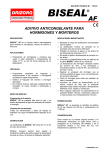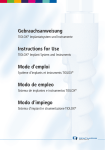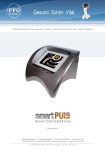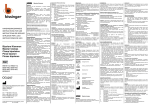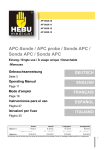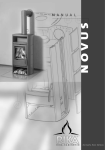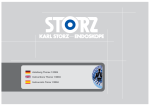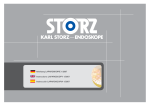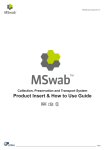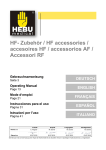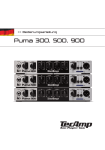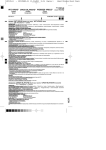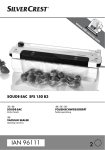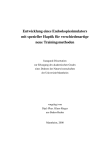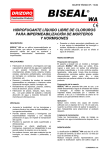Download DEUTSCH ENGLISH ITALIANO
Transcript
HF 9581-20 HF 9581-37 Gefäßversiegelungsinstrument BiSeal® mit Schneidefunktion Vessel sealing instrument BiSeal® with cutting function Strumento per sigillatura dei vasi BiSeal® con funzione di taglio Gebrauchsanweisung DEUTSCH Seite 3 Operating Manual ENGLISH Page 11 Istruzioni per l'uso ITALIANO Page 19 Name/name Erstellt C. Wagner Geprüft M. Dorner Freigegeben M. Dorner Inkraftgetreten M. Dorner Datum/date 02.07.2015 02.07.2015 02.07.2015 03.07.2015 Der Benutzer hat sich bei Nutzung einer Kopie der Konformität mit der aktuellen Version im jeweiligen Inhaltsverzeichnis zu vergewissern. DE 2 HEBU medical DE HEBU medical HF 9581-20 HF 9581-37 Gefäßversiegelungsinstrument BiSeal® mit Schneidefunktion Inhalt 1 Hinweise zu dieser Gebrauchsanweisung ............................................................................ 4 2 Anwendungs- und Sicherheitshinweise ................................................................................ 4 3 Bestimmungsgemäßer Gebrauch ......................................................................................... 5 4 Lieferumfang ......................................................................................................................... 6 5 Anwendung ........................................................................................................................... 6 5.1 5.2 6 6.1 6.2 6.3 7 7.1 7.2 Funktionsprüfung im sterilen OP-Bereich .......................................................................... 6 Bedienung ......................................................................................................................... 6 Montage und Demontage ..................................................................................................... 7 Klingendemontage ............................................................................................................ 7 Reinigung .......................................................................................................................... 8 Klingen Montage ............................................................................................................... 8 Wiederaufbereitung............................................................................................................... 9 Maschinelle Wiederaufbereitung ....................................................................................... 9 Manuelle Wiederaufbereitung ........................................................................................... 9 8 Lagerung............................................................................................................................. 10 9 Garantie .............................................................................................................................. 10 10 Hersteller – und Service- Adresse ...................................................................................... 10 3 DE HEBU medical 1 Hinweise zu dieser Gebrauchsanweisung Bei Nichtbeachtung der Gebrauchsanweisung besteht die Möglichkeit einer schweren oder sogar tödlichen Verletzung des Patienten oder des Anwenders! ! Sorgen Sie dafür, dass die folgenden Hinweise verstanden und beachtet werden! • Jeder Anwender muss die Gebrauchsanweisung vollständig lesen und beachten. • Insbesondere alle Vorsichts-, Warn- und Gefahrenhinweise beachten. • Die Gebrauchsanweisung muss dem Anwender jederzeit zugänglich sein. • Der vorliegende Text bezieht sich gleichermaßen auf männliche und weibliche Personen. Allein aus Gründen der besseren Lesbarkeit wurde auf die zweifache Schreibweise verzichtet. 2 Anwendungs- und Sicherheitshinweise Falsche Bedienung und Nichtbeachtung von Vorsichtsmaßnahmen können schwerwiegende Zwischenfälle verursachen. Informieren Sie sich deshalb bitte, anhand dieser Gebrauchsanweisung und anhand der Gebrauchsanweisung des Hochfrequenz-Chirurgiegerätes über die Funktionsweise und die sichere Handhabung. Unsachgemäße Handhabung und Pflege sowie zweckentfremdeter Gebrauch können zu vorzeitigem Verschleiß des chirurgischen Instrumentes führen. ! ! ! ! ! ! ! ! ! ! ! ! Alle Instrumente müssen vor der ersten Ingebrauchnahme und vor jeder weiteren Anwendung komplett gereinigt, desinfiziert und sterilisiert werden. Es ist sehr wichtig, jedes chirurgische Instrument vor jedem Gebrauch auf sichtbare Beschädigungen und Verschleiß, z.B. Risse, Brüche oder Defekte an der Isolation zu untersuchen. Vor allem Bereiche wie Schneiden, Spitzen, Schlüsse, Sperren und Rasten, sowie alle beweglichen Teile, Isolationen und keramischen Elemente sind sorgfältig zu prüfen. Setzen Sie niemals beschädigte Instrumente ein. Nicht in Gegenwart von brennbaren oder explosiven Stoffen verwenden. Das Instrument darf nicht auf dem Patienten abgelegt werden. Bedenken Sie die Grenzen der Methode! Führen Sie keine Versiegelung von Gefäßen oberhalb des maximalen Durchmessers von 7 mm durch! Benutzen Sie das Instrument ausschließlich gemäß Zweckbestimmung! Eileiterkoagulationen mit dem BiSeal® Instrument sind kein sicheres Sterilisationsverfahren! Vor der Anwendung muss eine Funktionsprüfung erfolgen! Der Klingenträger ist nach jedem Anwendungszyklus zu wechseln! Benutzen Sie den Klingenträger nicht zweimal! Beim Eintauchen des Maulteiles in elektrisch leitende Flüssigkeiten erfolgt keine sichere Gefäßversiegelung, da der Strom über die Flüssigkeit geleitet wird (Nebenschluss)! Die äußeren Oberflächen des Maulteiles sind durch Wärmeleitung auch nach Koagulationsende so heiß, dass sie ungewollte Verbrennungen verursachen können. Gewebeberührungen unmittelbar nach Versiegelungsende sind zu vermeiden! 4 DE HEBU medical ! ! ! ! ! Betätigen Sie den Klingenträger nicht vor der Versiegelung des gefassten Gewebes – Blutungsgefahr. Den Schnitt erst nach ordnungsgemäßem Quittieren des Versiegelungsvorganges durch das HF-Gerät durchführen! Zwischen den Branchen, in der Klingenführung und den Gelenken, können sich Gewebereste festsetzen, die eine Funktionsbeeinträchtigung verursachen (Elektrische Nebenschlüsse, Klingenträger klemmt). Für diese Fälle muss das Instrument mittels des mitgelieferten Reinigungswerkzeuges, einer Bürste oder eines Tupfers sowie sterilem Wasser zwischendurch gereinigt werden. Während der Gefäßversiegelung muss die Klinge in das Maulteil zurückgezogen sein, da sie sonst einen Kurzschluss verursacht und keine Versiegelungswirkung eintritt. Beginnen Sie mit niedriger Leistungseinstellung und erhöhen Sie die Leistung bei Bedarf. Bei schlechter oder ausbleibender Versiegelungswirkung Fehler suchen, nicht einfach die HF-Leistungseinstellung bis zum Maximum erhöhen! Das Anschlusskabel sollte so geführt werden, dass es weder den Patienten noch andere Leitungen berührt. Das Kabel vor mechanischen Beschädigungen (Überfahren, Quetschen, Knicken) schützen. Zusätzliche Hinweise bei laparoskopischen Einsätzen Nur versiegeln, wenn sich das Maulteil des Instrumentes im Sichtbereich befindet! Unbeabsichtigte Aktivierung oder Bewegung des Instrumentes kann zur Verletzung des Patienten führen! ! ! ! Die Strom führenden Elektroden im Maulteil müssen beim Aktivieren einen Sicherheitsabstand von mindestens 2 cm zum metallischen Trokarende haben. Instrument nur mit geschlossenem Maulteil in den Trokar einführen und herausziehen! 3 Bestimmungsgemäßer Gebrauch ® ® Das Gefäßversiegelungsinstrument BiSeal ist ausschließlich zur Verwendung mit BiSeal -Geräten der HEBUmedical GmbH bestimmt. Dazu sind die Hinweise in der Gebrauchsanweisung des verwendenden Gerätes zu beachten. ® Das Gefäßversiegelungsinstrument BiSeal wird in der minimalinvasiven Chirurgie, insbesondere der Laparoskopie eingesetzt. Hierbei können die Instrumente durch 10mm- Trokarhülsen eingeführt werden. ® Das Gefäßversiegelungsinstrument BiSeal dient dem dauerhaften Verschluss von Venen, Arterien und Gewebebündeln mit anschließender Trennung ohne Instrumentenwechsel. Dabei können Gefäße bis zu einem maximalen Durchmesser von 7 mm dauerhaft versiegelt werden. Das Instrument wird über ein Anschlusskabel an den entsprechenden bipolaren Ausgängen des HF-Generators angeschlossen. ® Das Gefäßversiegelungsinstrument BiSeal ist in den Arbeitslängen 200 mm (HF 9581-20) und 370 mm (HF 958137) erhältlich. Durch das Zusammenspiel von mechanischem Druck (p) und hochfrequentem Strom(I) wird an Arterien, Venen oder Gewebebündeln eine verlässliche und permanente Versiegelungszone erzeugt. Dabei ist es von entscheidender Bedeutung, dass der Druck während der gesamten Anwendungsdauer konstant aufrechterhalten wird. ! Koagulationsinstrumente dürfen nur von Personen eingesetzt werden, die speziell dafür ausgebildet oder eingewiesen sind. Es können Gefäße bis zu einem maximalen Durchmesser von 7 mm dauerhaft versiegelt werden. Bei großen Gefäßen wird eine doppelte, nebeneinander angebrachte Koagulation empfohlen. Diese kann dann mittig geschnitten werden. 5 DE HEBU medical 4 Lieferumfang Das Instrument muss sofort nach dem Empfang auf den korrekten Inhalt sowie dessen Unversehrtheit überprüft werden. Eventuelle Transportschäden sind unverzüglich zu melden. HF 9581-20 oder HF 9581-37 Gefäßversiegelungsinstrument BiSeal® 200mm oder 370mm HB 2310 Nadelhalter- zum sicheren Entfernen der Klingen HF 9581-01 Einweg-Ersatzklingen - Gebrauchsanweisung 5 Anwendung 5.1 Funktionsprüfung im sterilen OP-Bereich Die mechanische Funktion ist vor Operationsbeginn, bei laparoskopischer Anwendung vor dem Einführen in den Trokar zu testen: Öffnen, Schließen, Verriegeln, Entriegeln, Bewegen der Klinge. Die elektrische Funktion des Instrumentes sollte vor der Anwendung überprüft werden (z. B. an einem mit NaClLösung getränkten sterilen Tupfer). 5.2 Bedienung Nach korrekter Montage und dem Anschluss an eine der beiden Bipolarbuchsen am ® HF-Generator, muss der „BiSeal “ Modus eingestellt werden. Anschließend wird das zu behandelnde Gewebe gefasst. Nach dem Fassen des Gewebes wird der Handgriff geschlossen. Die Auslösung des Versiegelungsstroms erfolgt mittels Fußschalter. Das System beendet den Prozess durch eine automatische Stoppfunktion (automatische Beendigung der HFStrom-Abgabe; akustische Quittierung). Danach kann mit der integrierten Klinge das versiegelte Gewebe durchtrennt werden. ! ! Überzeugen Sie sich vor Versiegelungsbeginn davon, dass keine Harnleiter, Nervenstränge, Darmschlingen oder andere Strukturen unbeabsichtigt gefasst wurden! Bei großen Gefäßen wird empfohlen zwei nebeneinander liegende Versiegelungen vorzunehmen und dann mittig zu trennen. 6 DE HEBU medical 6 Montage und Demontage 6.1 Klingendemontage 1. Abzug bis zur Hälfte auslösen 2. Klinge mit dem Nadelhalter herausziehen und ordnungsgemäß entsorgen ACHTUNG! ! Klingen nie mit den Fingern heraus nehmen - Verletzungsgefahr! 7 DE HEBU medical 6.2 Reinigung 3. Klingenführung oben & unten reinigen 6.3 Klingen Montage 4. Neue Klinge einsetzen bis Sie eingerastet ist, dann erst die Schutzkappe entfernen 8 HEBU medical DE 7 Wiederaufbereitung 7.1 Maschinelle Wiederaufbereitung ® Wir garantieren eine Mindestzahl von 55 Aufbereitungszyklen für das chirurgische Instrument BiSeal . Die Klingenträger sind als unsterile Einmalprodukte konzipiert. Die Gewährleistung erlischt nach einmaligem Gebrauch. Die Lebensdauer der Instrumente wird durch deren Funktion und den schonenden Umgang mit ihnen bestimmt. Instrumente für die Elektrochirurgie unterliegen naturgemäß einem erhöhten Verschleiß in Abhängigkeit von Art und Dauer der Anwendung. Vorbereitung: Direkt nach der Anwendung groben Schmutz von den Instrumenten entfernen. Keine fixierenden Mittel oder heißes Wasser (>40°C) benutzen, da das zur Fixierung von Rückständen führt und den Reinigungserfolg beeinträchtigen kann. !!!Wichtig, auch innen am Gewinde des Maulteils!!! ! Benutzen Sie keine ätzenden Reinigungsmittel. Mittel mit einem neutralen pH-Wert sind am besten geeignet. Desinfektion: Maschinelle, thermische Desinfektion unter Berücksichtigung der nationalen Anforderungen bezüglich des A0 Wertes (siehe ISO 15883) durchführen. Trocknung: Trocknung der Außenseite der Instrumente durch den Trocknungszyklus des Reinigungs-/Desinfektionsgerätes. Falls notwendig, kann zusätzlich eine manuelle Trocknung mit Hilfe eines flusenfreien Tuches erreicht werden. Hohlräume von Instrumenten mit steriler Druckluft trocknen. 7.2 Manuelle Wiederaufbereitung Reinigung: Bereiten Sie ein Reinigungsbad gemäß Herstellerangaben zu. • • • • Produkte solange unter kaltem Leitungswasser (<40°C) spülen, bis alle sichtbaren Verschmutzungen entfernt wurden. Festsitzender Schmutz ist mit einer weichen Bürste zu entfernen. Produkte in das vorbereitete Reinigungsbad komplett einlegen. Einwirkzeit gemäß Herstellerangaben einhalten. Reinigen Sie das eingelegte Instrument manuell mit einer weichen Bürste. Alle Flächen müssen mehrfach abgebürstet werden. Spülen Sie die Produkte äußerst gründlich unter fließendem Leitungswasser zur restlosen Entfernung des Reinigungsmittels. Desinfektion: • • • Bereiten Sie ein Desinfektionsbad gemäß den Angaben des Desinfektionsmittelherstellers zu. Legen Sie die Instrumente in das Desinfektionsbad ein und beachten Sie dabei die vorgeschriebene Einwirkzeit. Spülen Sie die Produkte äußerst gründlich mit VE Wasser zur restlosen Entfernung des Desinfektionsmittels. 9 DE HEBU medical Trocknung: Die manuelle Trocknung erfolgt mittels eines flusenfreien Tuches. Die Trocknung von Hohlräumen und Kanälen erfolgt mit steriler Druckluft. Funktionsprüfung: Optische Begutachtung auf Sauberkeit; ggf. Montage und Funktionstest gemäß Bedienungsanleitung. Falls notwendig, den Wiederaufbereitungsprozess wiederholen bis das Instrument optisch sauber ist. Der ursprüngliche Glanz kann durch Abreiben mit einem Putztuch wiederhergestellt werden. Dampfsterilisation: Sterilisation der Produkte mit fraktioniertem Pre-Vakuum-Verfahren (gem. ISO 13060 / ISO 17665) unter Berücksichtigung der jeweiligen nationalen Anforderungen. • 3 Vorvakuumphasen unter min. 60 mbar. • Aufheizung auf eine Sterilisationstemperatur von mindestens 132°C; max. 137°C. • Kürzeste Haltezeit: 3 min. • Trockenzeit: mindestens 10 min. 8 Lagerung Lagerung der sterilisierten Instrumente in einer trockenen, sauberen und staubfreien Umgebung bei moderaten Temperaturen von 5°C bis 40°C. 9 Garantie Wir leisten für alle HEBU Produkte Garantie gemäß den gesetzlichen und länderspezifischen Bestimmungen (Nachweis durch Rechnung oder Lieferschein). Die Garantiezeit beträgt zwei Jahre. Schäden, die durch unsachgemäße Behandlung oder normale Abnutzung entstanden sind, bleiben von der Garantie ausgeschlossen. Im Garantiefall legen Sie bitte eine Kopie der Rechnung oder des Lieferscheins bei. 10 Hersteller – und Service- Adresse HEBU medical GmbH Badstraße 8 78532 Tuttlingen / Germany Tel: Fax: +49 74 61 / 94 71 - 0 +49 74 61 / 94 71 - 22 eMail: [email protected] Web: www.HEBUmedical.de 10 EN HEBU medical HF 9581-20 HF 9581-37 Vessel sealing instrument BiSeal® with cutting function Table of Contents 1 Directions for user manual...................................................................................................... 12 2 Application and Safety ........................................................................................................... 12 3 Intended Use ......................................................................................................................... 13 4 Scope of delivery................................................................................................................... 14 5 Application ........................................................................................................................... 14 5.1 5.2 6 6.1 6.2 6.3 7 7.1 7.2 Functional check in the sterile operation area ........................................................................ 14 Operating .......................................................................................................................... 14 Assembly and disassembly ..................................................................................................... 15 Assembly of blade ............................................................................................................. 15 Cleaning ........................................................................................................................... 16 Blade assembly.................................................................................................................. 16 Reprocessing ........................................................................................................................ 17 Mechanical Reprocessing ................................................................................................... 17 Manual reprocessing .......................................................................................................... 17 8 Storage ................................................................................................................................. 18 9 Warranty .............................................................................................................................. 18 10 Manufacturer and Service address ........................................................................................... 18 EN HEBU medical 1 Directions for user manual ! In case of disregarding the user manual, there is the possibility of serious or fatal injury to the patient or operator! Make sure that the following directions are understood and complied with! • Every user is to read the manual completely and follow all instructions. • Special attention must be paid to all information about precautions, warnings and dangers. • The user manual must be readily accessible to the operator at any time. 2 Application and Safety Wrong application and disregard of cautionary instructions can cause serious incidents. Therefore please inform yourself with the assistance of this user manual, as well as the instructions of the electrosurgical unit, about all functions and the safe handling of this instrument. Improper handling or maintenance, as well as inappropriate use can lead to premature wear and tear of the instrument. ! ! ! ! ! ! ! ! ! ! ! ! All instruments must be completely cleaned, disinfected and sterilized, before being put into use and before every other further application. It is very important to inspect each surgical instrument for visible damage and wear, e.g. cracks, fractures or fissures in the insulation before every use. In particular areas such as blades, points, locks, ratchets, latches and any moving parts, insulation and ceramic parts are to be carefully examined. Do not use damaged instruments. Do not use in the presence of flammable or explosive substances. The instrument should not be placed on the patient. Bear in mind the limitations of this treatment method! Do not attempt to seal vessels which are wider than the maximum diameter of 7 mm! Use the instrument solely according to its intended purpose. Coagulation of fallopian tubes with the BiSeal® instrument is not a safe method of sterilization! A functional check must be done before implementation. The blade carrier must be exchanged after each application. Never use the same blade carrier twice! When submerging the jaw parts into electrically conducting liquids, no safe vessel sealing is possible, due to the current being conducted by the liquid (shunt circuit)! Even after ending the coagulation process, the outer surfaces of the jaw parts can be very hot and cause unwanted burns. Any touching of tissue immediately after the end of the sealing process is to be avoided! 12 EN HEBU medical ! ! ! ! ! Do not activate the blade carrier before the sealing of the grasped vessel is completed – danger of bleeding! Only after the electrosurgery unit has confirmed the proper vessel sealing process, the cut can be made. Between the branches, in the blade duct and in the joints, rest substances might get deposited, which can cause a deterioration of function. (Electric shunt circuit, blade carrier gets stuck). In such cases the instrument must be cleaned during applications by use of delivered cleaning tools, a brush or a swab, as well as sterilized water. During vessel sealing the blade must be retracted into the jaw parts, otherwise it can cause a short circuit and no sealing function can be effected. Start with a low power output and increase the output according to requirement. If the sealing function is poor or not at all effective, look for cause. Do not simply turn the output power up to maximum. The connection cable should be aligned in such a way that it does not touch the patient, nor has any contact with other cables. Protect the cable from mechanical damage (running over, squeezing, bending). Additional directions for laparoscopic applications ! ! ! Only do vessel sealing when the jaw parts of the instrument are visible for the operator. Unintentional activation or motion of instrument can lead to injury of patient! The electrodes inside the jaw parts carrying current must have a safety distance of at least 2 cm to metallic end of trocar, when activated. Insert and withdraw the instrument into/from the trocar with closed jaw parts only! 3 Intended Use ® The vessel sealing instrument BiSeal is intended to be used exclusively with units which are equipped with the ® BiSeal -function from HEBU medical GmbH. Attention must be paid to the directions given in the manual ® instructions as delivered with the unit. The BiSeal vessel sealing instrument is used for minimally invasive surgery, in particular for laparoscopy. The instrument can be inserted through the 10 mm trocar. Its purpose is to permanently seal veins, arteries and bundles of tissue, and thereafter implement the separation by cutting, without having to change instruments. Hereby vessels with a diameter of up to 7 mm can be permanently sealed. A cable connects the instrument to the HF-generator´s bipolar sockets. ® The vessel sealing instrument BiSeal is available in working lengths of 200 mm (HF 9581-20) and 370 mm (HF 9581-37). Due to interaction of mechanical pressure (p) and high-frequency current (l) a permanently and reliably sealed area of veins, arteries or tissue bundles is created. Hereby it is of significant importance that the pressure is being kept constant during the entire application period. ! Instruments for coagulation may only be used by persons who received special training or instructions in the use of such. Vessels with a diameter of up to 7 mm can be permanently sealed. For large vessels it is recommended to make a double coagulation, one next to the other. After sealing, it can be cut in the middle. 13 EN HEBU medical 4 Scope of delivery The instrument must be checked for correct contents as well as for being undamaged immediately upon delivery. In case of damages occurred during transport, these are to be reported right away. HF 9581-20 or HF 9581-37 Vessel sealing instrument BiSeal® 200 mm or 370 mm HB 2310 Needle holder – for save removal of the blades HF 9581-01 Disposable replacement blades - Manual Instruction 5 Application 5.1 Functional check in the sterile operation area The mechanical function must be checked before begin of operation, and by laparoscopic applications before inserting into the trocar: Opening, closing, locking, unlocking, moving the blade. The electric function of the instrument should be checked before each application, e.g. on a sterile swab soaked with NaCl-solution. 5.2 Operating ® After correct assembly and connection to one of the bipolar sockets on the HF-generator, set to BiSeal mode. Then grasp the tissue which is to undergo treatment. Afterwards close the handle. The sealing current is activated by use of the foot switch. The system ends the process by an automatic stop-function (automatic stop of flow of the high-frequency current, audible confirmation). Following this, the sealed tissue can be cut with the integrated blade. ! ! Before beginning the sealing process, make sure that no ureter, nerve cords, intestinal loops or any other structures are grasped unintentionally! For large vessels it is recommended to make a double coagulation, one next to the other. After sealing, it can be cut in the middle. 14 EN HEBU medical 6 Assembly and disassembly 6.1 Assembly of blade 1. Pull down safety latch and push halfway in 2. Remove blade with needle holder and dispose according to safety standards. Attention! ! Never remove blade with fingers – danger of injury!!! 15 EN HEBU medical 6.2 Cleaning 3. Clean upper and lower parts of blade duct 6.3 Blade assembly 4. Insert new blade until it is caught in. Only then remove protective cap. 16 EN HEBU medical 7 Reprocessing 7.1 Mechanical Reprocessing ® We guarantee a minimum of 50 reprocessing cycles for the surgical instrument BiSeal . The blade carriers are devised as a non-sterile single-use product. The warranty expires after using them once. The durability of the instrument depends on its functions and on careful handling. Instruments for electro surgery are naturally subject to a higher wear and tear, depending on the way and duration of usage. Preparation: Remove coarse dirt from the instruments immediately after application. Do not use fixation agents or hot water (> 40 ° C), because this may lead to the fixation of residues and may impair the cleaning results. !!! Important: also clean inside at thread of jaw parts!!! ! Do not use any kind of acidly cleaning detergents. Substances with a neutral pH-value are most suitable. Disinfection: Mechanical, thermic disinfection should be carried out under consideration of the national guidelines with regard to the A0 value (see ISO 15883). Drying: Dry the outside of the instrument using the drying cycle of the cleaning/disinfection unit. Additionally, if necessary, it can be dried manually using a lint-free cloth. Dry the cavities of instruments with sterile air. 7.2 Manual reprocessing Cleaning: !!! Instruments must be disassembled before cleaning!!! Prepare a cleaning bath according to manufacturer instructions. • • • • Rinse the instruments with cold tap water (<40 ° C) until all visible contaminants are removed. Imbedded dirt is removed with a soft brush. Submerge the instruments completely in the prepared bath. Induction period according to manufacturer’s instruction. Clean the submerged instruments manually with a soft brush. All surfaces must be brushed several times. Rinse the products very thoroughly with running tap water for complete removal of detergent. Disinfection: • • • Prepare a disinfectant bath according to information provided by the disinfectant´s manufacturer. Place the instruments into the disinfectant and observe the prescribed contact time. Rinse the products very thoroughly with deionized water to completely remove the disinfectant. 17 EN HEBU medical Drying: The manual drying is effected by a lint-free cloth and, in particular for drying cavities and canals, by sterile compressed air. Functional check: Visual inspection for cleanliness, if applicable, assembly and functional test according to the manual. If necessary, repeat the treatment process until the instrument is visually clean. The original shine can be restored by polishing with a soft cloth. Steam sterilization: Sterilization of instruments by fractional pre-vacuum procedure (according to ISO 13060 / ISO 17665) taking into account the national guidelines of the respective country. • 3 pre-vacuum phases with at least 60 mbar • Heating to a sterilization temperature of at least 132 ° C, max. 137 °C • Shortest time: 3 min. • Drying time: at least 10 min. 8 Storage Store sterilized instruments in a clean, dry and dust-free environment at moderate temperatures of 5°C to 40°C. 9 Warranty We provide a guarantee for all HEBUmedical products in accordance with statutory and country-specific legislation (proof of purchase by invoice or delivery note). The warranty period is two years. Damage caused by incorrect handling or normal wear and tear is not covered by the warranty. In case of warranty claims, please enclose a copy of the invoice or delivery note with the device. 10 Manufacturer and Service address HEBUmedical GmbH Badstraße 8 78532 Tuttlingen Germany Tel.: 07461 / 9471-0 Fax: 07461 / 9471-22 eMail: [email protected] web: www.HEBUmedical.de 18 IT HEBU medical HF 9581-20 HF 9581-37 Strumento per sigillatura dei vasi BiSeal® con funzione di taglio Inhalt 1 Indicazioni sul manuale d'uso ............................................................................................. 20 2 Utilizzo e disposizioni di sicurezza ...................................................................................... 20 3 Destinazione d'uso.............................................................................................................. 21 4 Elenco materiale incluso nella fornitura .............................................................................. 22 5 Applicazione pratica ............................................................................................................ 22 5.1 5.2 6 6.1 6.2 6.3 7 7.1 7.2 Controllo funzionale nel campo operatorio sterile ........................................................... 22 Utilizzo ............................................................................................................................. 22 Montaggio e smontaggio dello strumento ........................................................................... 23 Montaggio della lama ...................................................................................................... 23 Pulizia .............................................................................................................................. 24 Montaggio della lama ...................................................................................................... 24 Trattamento di pulizia.......................................................................................................... 25 Pulizia meccanica............................................................................................................ 25 Pulizia manuale ............................................................................................................... 25 8 Stoccaggio .......................................................................................................................... 26 9 Garanzia ............................................................................................................................. 26 10 Indirizzo del produttore/manutentore .................................................................................. 26 19 IT HEBU medical 1 Indicazioni sul manuale d'uso Nel caso il presente manuale non venga rispettato esistono serie possibilità di causare danni a pazienti o personale utilizzatore! ! Accertarsi che le presenti disposizioni vengano comprese e seguite dal personale utilizzatore! • Leggere attentamente il presente manuale e seguirne le istruzioni. • Fare particolare attenzione alle indicazioni di sicurezza e pericolo. • Tenere il presente manuale sempre alla portata di tutti. 2 Utilizzo e disposizioni di sicurezza Disattendere o non applicare correttamente le indicazioni di sicurezza del presente manuale può causare seri incidenti. Pertanto è necessario seguire attentamente le seguenti disposizioni e le istruzioni dell'apparecchio per elettrochirurgia. L'uso improprio o la mancata manutenzione possono inoltre notevolmente ridurre la vita dall'apparecchio. ! ! ! ! ! ! ! ! ! ! ! ! Tutti gli strumenti devono essere attentamente puliti, disinfettati e sterilizzati prima di essere utilizzati.. E' molto importante procedere ad un'attenta ispezione visiva degli strumenti prima dell'uso, soprattutto nelle aree più delicate (punte, lame, denti, chiusure, parti mobili, isolamento e parti ceramiche) al fine di controllare eventuali danni. Non utilizzare strumenti danneggiati. Non utilizzare gli strumenti in presenza di sostanze infiammabili o esplosive. Gli strumenti non devono essere posizionati sopra al paziente. Bisogna tenere presente i limiti di utilizzo dello strumento! Non utilizzare per la sigillatura di vasi con diametro superiore a 7 mm. ! Utilizzare lo strumento solamente secondo la sua destinazione d'uso! L'utilizzo dello strumento per la chiusura delle tube di Faloppio non è un metodo di sterilizzazione sicuro! Procedere ad un controllo funzionale prima dell'utilizzo! Le lame di ricambio devono essere sostituite dopo ogni utilizzo. Non usare due volte la stessa lama! Se il morso della pinza viene immerso in un liquido conduttivo non s' possibile effettuare la sigillatura dei vasi, perché' si genera un corto circuito! La superficie del morso della pinza può essere molto calda dopo l'uso. Evitare di toccarla dopo l'uso! 20 IT HEBU medical ! ! ! ! ! Non attivare la lama prima di aver terminato la procedura di sigillatura del vaso; questo potrebbe causare sanguinamento! Solamente dopo che l'apparecchio ha segnalato la fine del processo di sigillatura è possibile eseguire il taglio! E' possibile che sulla lama e le articolazioni della pinza si depositino delle sostanze che possono deteriorare la funzionalità dello strumento. In questi casi è necessario pulire lo strumento durante la procedura, utilizzando una spazzola e acqua sterile. La lama deve essere ritirata durante la procedura di sigillatura dei vasi, per evitare corti circuiti che possono ridurne l'efficacia. Iniziare la procedura utilizzando una potenza bassa ed aumentarla secondo necessità. Se l'effetto di sigillatura non è efficace è necessario capirne le cause, non solamente aumentare la potenza dell'apparecchio. Disporre il cavo di connessione in modo che non tocchi il paziente o sia a contatto con altri cavi. Proteggere il cavo da danni di tipo meccanico (piegature, schiacciamento ecc.) Indicazioni aggiuntive per procedure laparoscopiche Procedere con la sigillatura dei vasi solamente quando le due parti terminali dello strumento sono in vista. L'attivazione involontaria dello strumento può causare danni al paziente! ! ! ! Quando vengono attivati, gli elettrodi che portano la corrente all'interno dello strumento devono avere una distanza di sicurezza di almeno 2 cm. Dalla parte terminale metallica del trocar. Inserire ed estrarre lo strumento dal trocar sempre con i morsi chiusi! 3 Destinazione d'uso ® Lo strumento per sigillatura di vasi BiSeal è stato progettato per l'utilizzo esclusivo con gli elettrobisturi prodotti ® dalla HEBUmedical GmbH che hanno la funzione BiSeal . ® È necessario leggere attentamente anche le istruzioni dell'apparecchiatura che si utilizza. Lo strumento BiSeal è utilizzato in chirurgia mininvasiva, soprattutto in laparoscopia. Lo strumento può essere inserito in un trocar da 10 mm. Il suo scopo è quello di sigillare in maniera permanente vene, arterie e pezzi di tessuto e successivamente di separarli con il taglio, senza cambiare strumento. In questo modo vasi con un diametro fino a 7 mm. Possono essere sigillati in maniera definitiva. Un cavo collega lo strumento alla presa bipolare dell'apparecchio Lo strumento è disponibile in due misure: 200 mm (HF 9581-20) e 370 mm (HF 9581-37). L'azione combinata della pressione meccanica e della corrente in alta frequenza genera una sigillatura di vasi, arterie e tessuti permanente e affidabile. E' pertanto necessario che la pressione sia mantenuta costante durante tutta la procedura di sigillatura. ! Gli strumenti per coagulazione devono essere utilizzati solamente da personale addestrato correttamente istruito. I vasi con un diametro fino a 7 mm. Possono essere sigillati permanentemente. Per vasi di dimensioni superiori è consigliabile procedere ad una doppia coagulazione, una accanto all'altra. Il taglio può essere fatto al centro delle due sigillature, una volta eseguite correttamente queste ultime. 21 IT HEBU medical 4 Elenco materiale incluso nella fornitura Al ricevimento della merce controllare il corretto contenuto del pacco, cosi come l’integrità del materiale contenuto. Qualsiasi danno occorso durante il trasporto va comunicato tempestivamente alla casa madre. HF 9581-20 oder HF 9581-37 Strumento di sigillatura dei vasi BiSeal® 200 mm. o 370 mm. HB 2310 Pinza per la rimozione della lama HF 9581-01 Lame di ricambio - Manuale di istruzioni 5 Applicazione pratica 5.1 Controllo funzionale nel campo operatorio sterile Effettuare un controllo meccanico di funzionalità prima di procedere con l'intervento laparoscopico: aprire, chiudere, bloccare, sbloccare lo strumento, muovere la lama. La funzionalità elettrica dello strumento può essere controllata prima dell'intervento, ad esempio utilizzando una garza sterile imbevuta. 5.2 Utilizzo Dopo aver correttamente assemblato e collegato lo strumento al generatore di HF, settare l'apparecchio nella ® funzione BiSeal . Il sistema termina automaticamente la procedura di sigillatura (interruzione trasmissione alta frequenza, avviso acustico contemporaneo). Al termine di questo processo è possibile resecare i tessuti con la lama integrata nello strumento. ! ! Prima di procedere con la sigillatura, controllare che non siano stati afferrati erroneamente nervi, uretere, anse intestinali. Per vasi molto grandi è consigliabile procedere ad una doppia coagulazione, una accanto all'altra. Il taglio può essere fatto al centro delle due sigillature, una volta eseguite correttamente queste ultime. 22 IT HEBU medical 6 Montaggio e smontaggio dello strumento 6.1 Montaggio della lama 1. Slegare il ritiro fino alla metà 2. Tirare fuori la lama con un portaaghi ed eliminarla regolarmente ATTENZIONE! ! Mai rimuovere la lama con le dita, questo può causare ferite! 23 IT HEBU medical 6.2 Pulizia 3. Purificare l´introduzione delle lame sopra e sotto 6.3 Montaggio della lama 4. Mettere dentro la nuova lama fino la lama è ingranata, poi togliere la protezione. 24 IT HEBU medical 7 Trattamento di pulizia 7.1 Pulizia meccanica ® Garantiamo normalmente 50 cicli di sterilizzazione per lo strumento BiSeal . Le lame sono invece considerate monouso, pertanto la garanzia decade dopo il primo utilizzo. La durata dello strumento dipende dal suo corretto utilizzo. Gli strumenti per elettrochirurgia sono naturalmente soggetti ad una maggiore usura. Preparazione: Immediatamente dopo l'uso è importante rimuovere lo sporco più grossolano dagli strumenti. Non utilizzare acqua calda (>40°C) o fissativi perché' il loro effetto potrebbe essere nocivo al processo di pulizia. !!!Pulire con attenzione anche l'interno del morso della pinza!!! ! Non utilizzare detergenti acidi. E' preferibile l'uso di detergenti con ph neutro. Disinfezione: È possibile utilizzare la disinfezione automatica, tenendo presente gli standard nazionali (ISO 15883). Asciugatura: Asciugare l'esterno dello strumento tramite il ciclo apposito della lavastrumenti. Se necessario procedere anche ad un'asciugatura manuale dello strumento con un panno privo di lanugine. Le cavità dello strumento possono essere asciugate con aria compressa sterile. 7.2 Pulizia manuale Pulizia: Procedere alla pulizia secondo le indicazioni del produttore. • • • • Risciacquare lo strumento con acqua fredda (<40°C) fino a rimuovere i frammenti visibili. Lo sporco più incrostato può essere rimosso con una spazzola morbida. Immergere completamente lo strumento nel liquido detergente. Seguire le indicazioni di pulizia date dal produttore. Spazzolare ripetutamente lo strumento immerso nel liquido con una spazzola morbida. Per rimuovere completamente il detergente sciacquare abbondantemente con acqua corrente. Disinfezione: • • • Preparare l'agente disinfettante secondo le indicazioni del produttore. Immergere lo strumento nel disinfettante, rispettando i tempi indicati dal produttore. Risciacquare molto bene con acqua deionizzata per rimuovere del tutto il disinfettante. 25 IT HEBU medical Asciugatura: L'asciugatura manuale si effettua con un panno morbido esente da lanugine. Per asciugare le caviate' e i canali utilizzare aria compressa sterile. Verifica funzionale: Controllare visivamente la pulizia e la funzionalità dello strumento, come indicato sul manuale. Se necessario, ripetere il procedimento fino ad ottenere una pulizia completa dello strumento. Dampfsterilisation: La sterilizzazione degli strumenti in vuoto frazionato (sec. ISO 13060/17665) deve seguire le normative nazionali.. • 3 fasi di vuoto con almeno 60 mbar. • Temperatura di esercizio di almeno 132°C, max. 137°C • Durata minima ciclo: 3 min. • Asciugatura: almeno 10 min. 8 Stoccaggio Gli strumenti sterilizzati devono essere immagazzinati in una ambiente pulito, asciutto, esente da polvere, a temperature comprese fra 5°C e 40°C. 9 Garanzia La garanzia sui prodotti HEBU viene rilasciata a fronte di una prova dell'acquisto dei prodotti secondo le normative nazionali. Il periodo di garanzia offerto è di due anni. Eventuali danni causati da uso improprio o normale usura sono esclusi dalla garanzia. Per ogni richiesta di intervento in garanzia è necessario inviare assieme allo strumento una copia della fattura o della ricevuta di acquisto del medesimo. 10 Indirizzo del produttore/manutentore HEBU medical GmbH Badstraße 8 78532 Tuttlingen / Germany Tel: Fax: +49 74 61 / 94 71 - 0 +49 74 61 / 94 71 - 22 eMail: [email protected] Web: www.HEBUmedical.de 26 HEBU medical IT 27 0123 Unser umfangreiches Sortiment umfasst über 10 000 verschiedene Instrumente. Besuchen Sie uns im Internet oder fordern Sie unseren Katalog an. Our vast range of products covers over 10 000 various instruments. They can be found in Internet or request our catalog. Notre assortiment complet comprend plus de 10 000 instruments differents. Vous le trouverez sur Internet. Ou bien demandez notre catalogue. Nuestro amplio instrumental consta de más de 10 000 artículos diferentes. Usted puede consultarlo en Internet o solicitor nuestro catálogo. HEBUmedical GmbH Badstraße 8 • 78532 Tuttlingen / Germany Tel. +49 (0) 7461 94 71 - 0 • Fax +49 (0) 7461 94 71 - 22 [email protected] • www.HEBUmedical.de GA HF110-04 V2.0 / 2015.07 Il nostro assortimento comprende più di 10 000 strumenti differente. Lei ci può vistare in Internet o chieda il nostro catalogo.




























